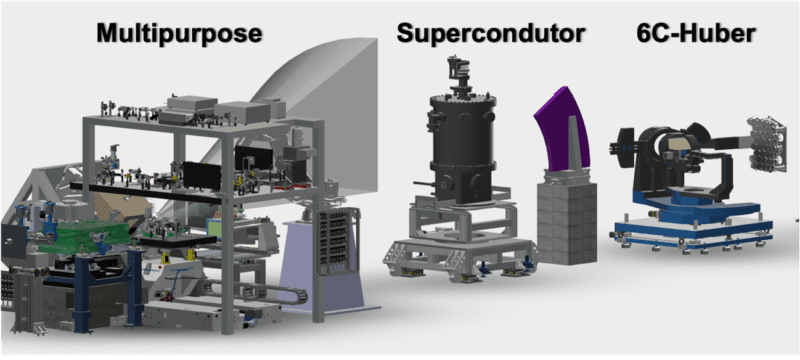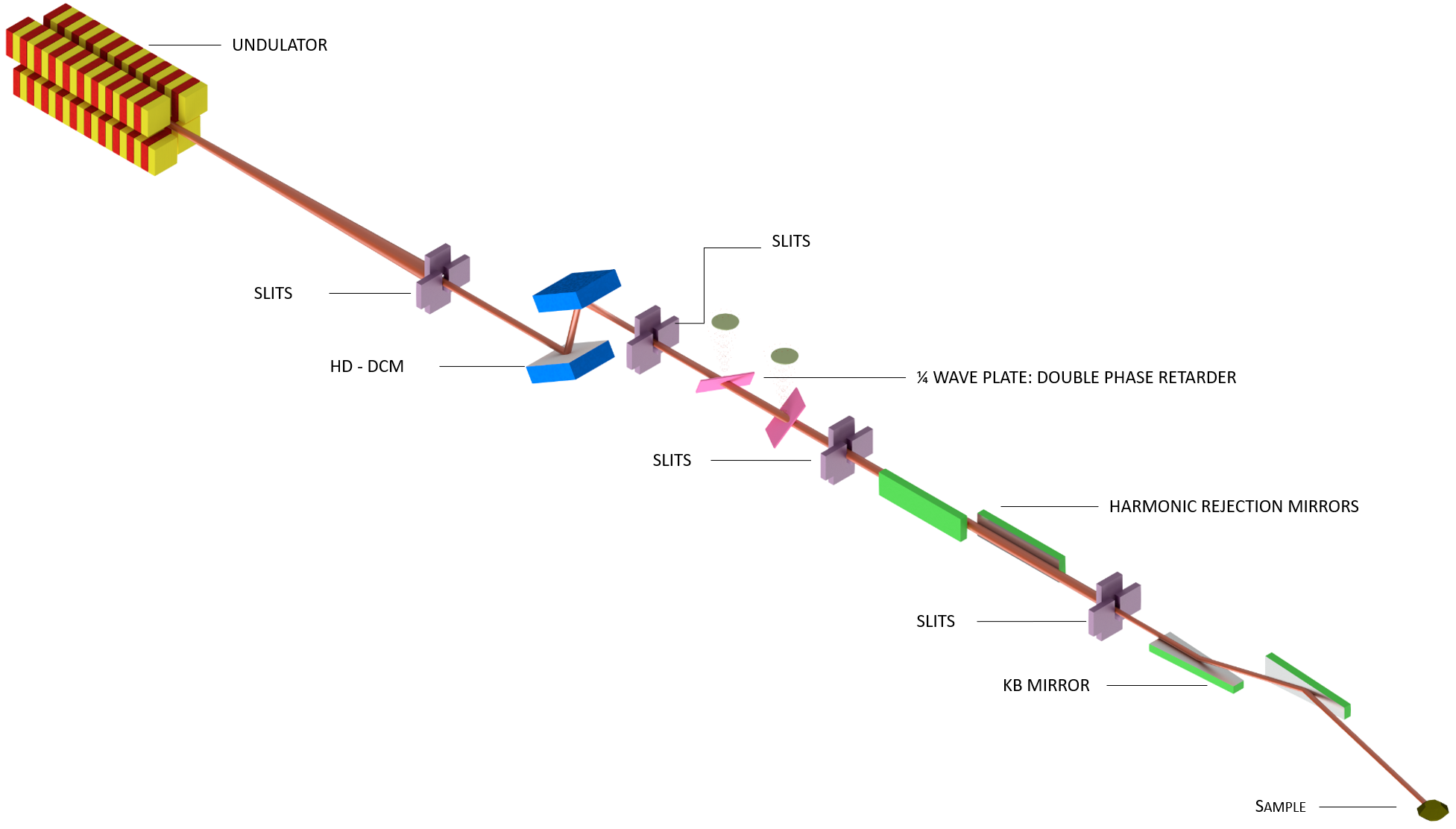CONTACT & STAFF
Facility Tel.: +55 19 3518 2448
Facility E-mail: ema@lnls.br
Coordination: Ricardo D. dos Reis
Tel.: +55 19 3512 3505
E-mail: ricardo.reis@lnls.br
Click here for more information on this Facility team.
The EMA (Extreme condition Methods of Analysis) beamline is planned to make a difference where a high brilliance (high flux of up to 1 x 1014 photons/sec with beamsize down to 0.1 x 0.1 μm2) is essential, as is the case with the study of materials under extreme thermodynamic (pressure, temperature and magnetic field) conditions.
This beamline is proposed to have two experimental hutches, microfocus and nanofocus stations, designed to allow great flexibility in combining extreme sample environments (high pressures (P < 1000GPa), high temperatures (T < 8000 K), low temperatures (T > 0.5 K) and high magnetic fields (B < 11T) with the most advanced synchrotron-based characterization techniques employed worldwide, which includes absorption spectroscopy, X-ray diffraction and X-ray scattering techniques. This combination will allow to explore yet unreached points of the P-T-B phase diagram to tackle complex scientific problems on the intersection between such thermodynamical conditions. Moreover, the wide variety of sample environments and characterization techniques available will allow the study of a wide range of materials covering several areas of knowledge, on both applied and fundamental science.
More details can be found at: R D dos Reis et al 2020 J. Phys.: Conf. Ser. 1609 012015
Facility Tel.: +55 19 3518 2448
Facility E-mail: ema@lnls.br
Coordination: Ricardo D. dos Reis
Tel.: +55 19 3512 3505
E-mail: ricardo.reis@lnls.br
Click here for more information on this Facility team.
The EMA microfocus station aims to combine x-ray techniques (XAS, XRD, XRS and CDI) with a beam size from 1 to 13 μm, depending on the experiment position, with several extreme thermodynamic conditions of pressure, temperature and magnetic field. In order to cover this broad range of techniques and thermodynamical conditions three experimental setups are displaced along the beam path and are named here as: multipurpose setup, superconducting (SC) magnet setup and 6C Huber setup:

Microfocus station of EMA beamline
The multipurpose setup, located at the beginning of hutch, 45.5 m from the source, has the smallest beamsize possible at the microfocus station (~1×0.4 μm2) which should allow X-ray spectroscopy, diffraction and imaging experiments to be performed up to pressures as high as 600 GPa, low and high temperatures (0.5 K to 8000 K) and under a moderate magnetic field up to 3 T at ambient pressure or 1 T under applied pressure. The magnetic field is obtained by resistive electromagnet (GMW 3474-140). A custom liquid Helium flow cryostat will cool down the samples by contact with a cold-finger tip and/or in contact cold Helium exchange gas to cover all shapes and kinds of samples and sample holders. Both of these modes of operation should allow to reach temperatures as low as 1.8 K. In addition, a He3 insert was designed to couple to the cryostat and allow to reach temperatures as low as 0.5 K. In any of these configurations the cool down time from room temperature should be on the order of 30 minutes. At this same setup it will also be possible to perform XRD experiments of the sample under low temperature by sliding the electromagnet to the side and fitting in an x-ray area detector with sample-detector distance between 0.1 to 4 meters. The area detector used for XRD experiments will be fixed in a robot arm allowing us to cover a large solid angle and sample-detector distance to allow mapping the reciprocal space. This possibility to easily move from XAS to XRD configuration will optimize the need to perform experiments at the same pressure and temperature conditions to determine both crystalline and electronic structures. Still in this multipurpose setup there will be the possibility to perform XRD and XAS experiments at temperatures as high as 8000 K by employing a dedicated double side laser heating optical apparatus.
At the middle of the experimental hutch, an 11 T superconducting magnet manufactured by Oxford Instruments will allow both XMCD/XANES and XRD experiments, with a focused x-ray beam size of about 6×2 μm2. The sample space of this magnet will be compatible with up to 50 mm standard symmetric diamond anvil cells, opening the possibility of combine the high magnetic field with high pressure and low temperatures (down to 0.5 K). Also, two optical windows will be disposed perpendicular to the beam direction for in situ pressure calibration. This optical window will be also used to a laser interferometer system that will guarantee the stability of the sample position during the measurements. A dilution He3 insert is also planned to be added at this magnet allowing the experiments XAS and XRD be performed in temperatures as low as 100 mK, however with a more limited sample space.
The third experimental setup, the 6C-Huber setup is based on a multi-axis diffractometer is positioned at 55 m from the source, allowing beamsizes of 13 x 3 μm2 (H x V). X-ray diffraction (XRD) experiments will be performed here on a Huber 6-circles (4S + 2D) under “psi” geometry, with an open Eurelian Cradle in the vertical scattering plane. The angular resolution of it is 0.0005º, with a sphere of confusion of ~2 μm, for the innermost sample axis (“phi”), and of ~30 μm for the other axes (“chi, eta, mu, del, nu”). Moreover, this equipment has a sample positioning system with movements along X-Y-Z (±75mm, ±75mm, ±13mm) or X-Y-Rx-Ry-Z (±6mm, ±6mm, ±15º, ±15º, ±13mm), while having a maximum free working distance of 66 mm and 30 mm, respectively. The available sample environments cover a temperature range between 5 and 300 K, pressures up to ~300 GPa by using DAC (“Diamond Anvil Cell”), uniaxial strain cell, and magnetic field up to 6T. Area (“2D”, Pilatus 100K and 300K), linear (“1D”, Mythen 1K), and punctual detectors (“0D”, scintillators) are available for this equipment. A Vortex-ME4 detector can be set for those experiments that also requires an elemental signature measurement by X-ray fluorescence (XRF). Also, regarding the X-ray detection, the diffractometer is equipped with a polarimeter and an analyzer crystal system. Therefore, this setup can be seen as an advanced platform focused on structural analysis that requires several degrees-of-freedom and makes use of characterization techniques based on XRD. It includes Resonant and Non-Resonant X-ray Magnetic Scattering (RXS e NRXMS), Crystal Truncation Rods (CTR), Diffraction Anomalous Fine Structure (DAFS), X-Ray Standing Waves (XSW), X-Ray Multiple Diffraction (XRMD), X-Ray Reflectivity (XRR), Texture and Residual Stress analysis, and Reciprocal Space Maps (RSM).
In addition, at 6C-Huber setup we have the capability to assembly X-ray Raman spectrometer, which open the possibility to probe light elements absorption edges (Carbon K-edge, in particular) with hard x-rays, which is fundamental to allow extreme conditions requirements such as diamond anvil cell or extreme low temperatures. On this setup, a 36 spherically bent crystal analyzers array will be mounted on the detector arm of the 6+2 circle diffractometer in order to increase solid angle acceptance and decrease collection time. This setup will work with both 0.5m and 1m radius of curvature analyzers depending on the need for higher collection efficiency or higher resolution.
At the nanofocus hutch the 100×100 nm2 focused beamsize is planned to be used for both x-ray diffraction and x-ray spectroscopy techniques of samples subjected to very extreme pressures with the small culet diamond shaped able to reach pressure up to 1TPa. This possibility to easily move from XAS to XRD configuration will optimize the need to perform experiments at the same pressure and temperature conditions to determine both crystalline and electronic structures. While the diffraction patterns will be recorded with Pymega540D area detector with sample-detector distance between 0.1 to 1 meter, the XAS spectra will be collect either using photodiodes and/or the 4-element fluorescence detector.
In order to improve the stability of the sample, that are essential in order to explore the nanosized beam, both the K-B mirror and the sample stage are built in the same granite block, and to avoid the acoustic vibration modes, the sample will always be mounted inside of vacuum chamber (10-4 mbar). To trackle the sample aligned to the x-ray spot position (within 10 nm) an interferometer-based feedback is planned. In combination with the pressure, we plan to have a capability to reach both low and high temperatures. For low temperatures, down to 4 K, a custom liquid Helium flow cryostat will cool down the samples by contact with a cold-finger and/or in contact cold Helium exchange gas to cover all shapes and kinds of samples and sample holders. Similar to the multipurpose setup of the microfocus statin, here we will have the possibility to the x-ray experiments at temperatures as high as 8000 K by employing a dedicated double side laser heating optical apparatus.

| Element | Type | Position (m) | Description |
|---|---|---|---|
| Source | Undulator | 0.0 | In vacuum undulator, 19 mm period |
| Monochromator | DCM | 28.5 | Vertical bounce, fixed exit. Si 111 and Si 220 |
| ¼ wave plate | Phase plate | 31.0 | Phase retarder for controlling the polarization |
| HRM | Mirrors | 33.3 | Harmonic rejection mirror pair. Si, Rh, Pt stripes |
| KB1 | Mirrors | 44.5 | Bendable vertical and horizontal focusing mirrors for the first experimental hutch |
| KB2 | Mirrors | 96.0 | Fixed curvature bent vertical and horizontal focusing mirrors for the second hutch |
| Parameter | Value | Condition |
|---|---|---|
| Energy range | 2.7 – 30 keV | |
| Energy resolution (ΔE/E) | 10−4 – 10−5 | |
| Harmonic content | < 10−5 | |
| Energy scanning | Yes | |
| Beam sizes | 100 x 100 nm2 to 10 x 10 μm2 | Dependent of the position |
| Beam divergences | 2 mrad to 20 μrad | Dependent of the position |
| Imaging modes | CDI, scanning | |
| Sample environments | Pressures of up to 1000 GPa Temperatures from 0.5 K to 8000 K Static magnetic fields up to 11 T |